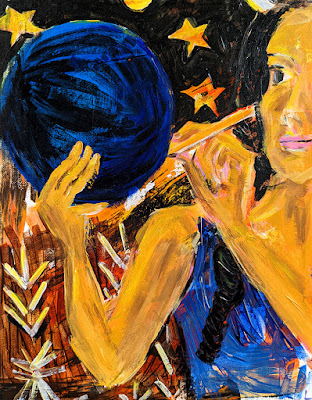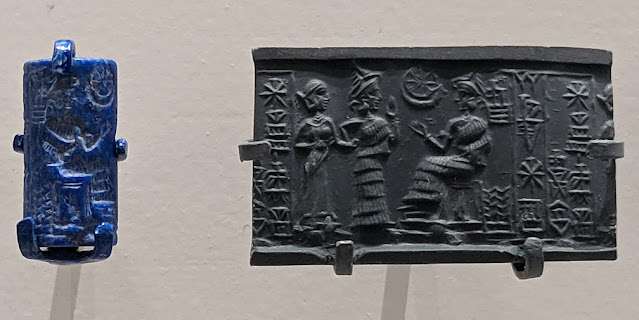Nisaba is the Sumerian goddess who invented written language. She likely began as a goddess of grain, and inspired her priestesses to keep track of the harvest with marks on clay tablets, which gradually become more complex until the first written alphabet was created. The cunieform symbol for Nisaba combines the symbols for deity and wheat.
She was the Goddess of scribes, and all writing began with her praises. She was described circa 2125 BC in the Gudea cylinder as holding a gold stylus and a clay tablet carrying the image of starry heaven. In the Hymn to Nisaba, her tablet is made is of lapis lazuli, a semi-precious gemstone prized for its deep blue color.
"Inscriptions make clear that her temple at Eresh was known as Esagin, 'House of Lapis Lazuli,' which was a center of worship for over 1,000 years. Her worship eventually seems to have consisted primarily of the act of writing; in composing a written work, an author was honoring the goddess with the gifts she had given. She became synonymous with wisdom and learning and was invoked regularly by scribes, scholars, priests, astronomers, and mathematicians for inspiration and guidance in their work" (source).
Nisaba was called "great knowledgeable perceptive one" and "woman who knows everything". An architect, she drew up temple plans for her people. She was also an accountant, an astrologer, an oracle, and an interpreter of dreams (source).
Hymn to Nisaba, circa 2500 BCE
Lady coloured like the stars of heaven, holding a lapis-lazuli tablet! Nisaba, great wild cow born by Urac, wild sheep nourished on good milk among holy alkaline plants, opening the mouth for seven ...... reeds! Perfectly endowed with fifty great divine powers, my lady, most powerful in E-kur!
Dragon emerging in glory at the festival, Aruru (mother goddess) of the Land, ...... from the clay, calming ...... (1 ms. has instead: the region with cool water), lavishing fine oil (3 mss. have instead: plenty) on the foreign lands, engendered in wisdom by the Great Mountain (Enlil)! Good woman, chief scribe of An, record-keeper of Enlil, wise sage of the gods!
In order to make barley and flax grow in the furrows, so that excellent corn can be admired; to provide for the seven great throne-daises by making flax shoot forth and making barley shoot forth at the harvest, the great festival of Enlil -- in her great princely role she has cleansed her body and has put the holy priestly garment on her torso.
In order to establish bread offerings where none existed, and to pour forth great libations of alcohol, so as to appease the god of grandeur, Enlil, and to appease merciful Kusu and Ezina, she will appoint a great en priest, and will appoint a festival; she will appoint a great en priest of the Land.
He (Enki (?)) approaches the maiden Nisaba in prayer. He has organised pure food-offerings; he has opened up Nisaba's house of learning, and has placed the lapis-lazuli tablet on her knees, for her to consult the holy tablet of the heavenly stars. In Aratta he has placed E-zagina at her disposal. You have built up Erec in abundance, founded from little ...... bricks, you who are granted the most complex wisdom!
(source)


Comments
Post a Comment